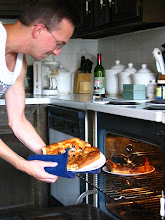A month or so ago, in the main dining room of the last cruise I'll ever take, I was offered a chocolate souffle.
The problem was, it was fake.
If you've ever had a real souffle, you know what it's supposed to be like: an incredibly delicious dessert with a weirdly perfect texture, halfway between liquid and air, that trembles and collapses with the first plunge of your spoon.
Sadly, this ersatz souffle was essentially a hypersweetened chocolate pudding/mousse mixture with a thin layer of what appeared to be cake batter poured on top of it. At least it was warm.
And not only was the souffle itself fake, but the entire rhythm of the souffle-ordering process was phony, as our waiter went around the table before dinner asking which of us would like the souffle, so he could "put the order in ahead of time." Thus was preserved the fiction that our souffles would be hand-made in advance for us.
I was more mad at myself than at the cruise line for this hilariously fake dining experience. I should have recognized the logistical impossibility of real souffles being lugged up from the ship's galley and heaved across the main dining room to you and 900 other guests at the same time. It doesn't matter how much you embellish the fiction by taking orders in advance. This ersatz "food" was quite clearly manufactured days--if not weeks--ahead of time.
But here's what's worse. I actually overheard people in that cruise ship dining room say they thought this phony souffle--not made, but rather shelf-stabilized, frozen and loaded onto the boat along with their suitcases--was absolutely amazing.
There are at least two distinct levels of tragedy here.
The first one is just a simple reality. When you sit down at almost all high-volume restaurants, the idea that your dinner entrees are actually "made" for you is a quaint fiction.
Instead a restaurant supply company--perhaps
Sysco Foods, some other food service company, or the restaurant chain's parent company--prepares, plates and freezes most of the food, puts it on a truck, and ships it to the restaurant.
Sure, these foods--in all their oversalted,
hyperpalatable and shelf-stabilized glory--might be customized a little bit with a fresh sauce, a side dish, or seasonings added by the restaurant staff. But make no mistake, most restaurant food is mass-produced, institutional food.
Foods are made this way
because they have to be. Feeding thousands of customers in chain restaurants, on cruise ships and in high-volume restaurants presents immense logistical challenges. The restaurant and its workers need to have a good chunk of their work done in advance. Then, they can just add a couple of minor final touches before that food gets into our bellies. And thanks to consumers being willing to consume this food, it's quite a profitable business.
A better question, however, is whether it's worth our money to purchase restaurant experiences like these.
But there's a second distinct level of tragedy here, and it's particularly depressing when I think about my ersatz souffle. Imagine an unsuspecting diner who never had a souffle before, and this was his first one. What happens someday down the road when he gets a
real souffle? An actual souffle that's good? There's an entirely good chance that he will prefer the phony ersatz souffle,
or even think that the ersatz souffle was the real thing and this real souffle isn't.It's getting to a point where the average American diner cannot tell the difference between food prepared in the ersatz style and food actually made at the place at which they are eating. Hey, the next time you visit a Chile's or a Cheesecake Factory, look around. People prefer ersatz foods!
Here's the point: we here in the United States do a bang-up job at manufacturing perfectly uniform, shelf-stabilized food that can be served in massive volumes. And manufactured food, when considered within its genre, doesn't have to be bad. Heck, I like an ice-cold Coke once in a while, and I would
die without my beloved Cool Ranch Doritos.
But don't try to fool us into thinking these are actually
foods. And that's the real tragedy of high-volume restaurant food.
One final thought: Serving a bad souffle isn't a crime. Serving a phony souffle isn't a crime either. But serving a bad, phony souffle to an audience
that doesn't know that they're being served a bad phony souffle... well, if that's not a crime, it should be.
When you go to restaurants, go small. Go local-owned and owner-operated. And try to order food that was actually made there, not purchased flash-frozen from a restaurant supply company.
Otherwise, why eat out?
Readers, what are your thoughts?How can I support Casual Kitchen?
If you enjoy reading Casual Kitchen, tell a friend and spread the word! You can also support me by purchasing items from Amazon.com via links on this site, or by linking to me or subscribing to my RSS feed. Finally, you can consider submitting this article, or any other article you particularly enjoyed here, to bookmarking sites like del.icio.us, digg or stumbleupon. Thank you for your support!
via links on this site, or by linking to me or subscribing to my RSS feed. Finally, you can consider submitting this article, or any other article you particularly enjoyed here, to bookmarking sites like del.icio.us, digg or stumbleupon. Thank you for your support!


